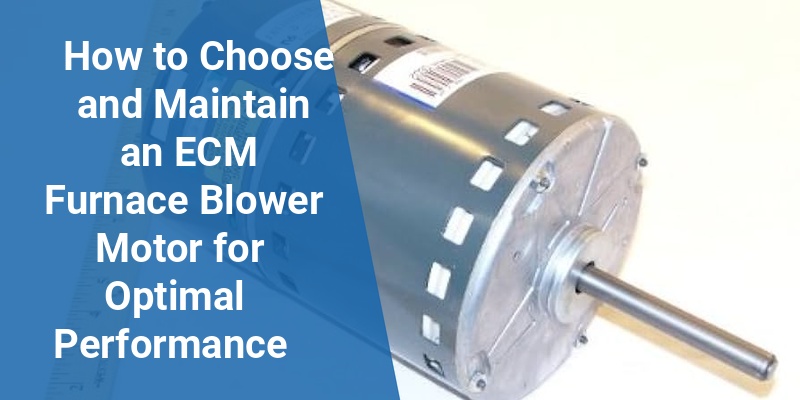The ECM furnace blower motor is a key component in modern heating systems, maximizing energy efficiency and improving airflow control. This motor type, which stands for Electronically Commutated Motor, integrates advanced electronics with permanent magnet technology. This article explores the functionality, benefits, selection criteria, and maintenance tips of ECM furnace blower motors, designed to help homeowners and HVAC professionals optimize system performance effectively.
| Aspect | Details |
|---|---|
| Motor Type | Electronically Commutated Motor (ECM) |
| Key Benefits | Higher efficiency, variable speed, quieter operation |
| Common Uses | Furnace blower motors, HVAC air handlers |
| Maintenance Needs | Regular cleaning, timely inspections, professional servicing |
| Replacement Signs | Excessive noise, reduced airflow, motor failure |
What Is An ECM Furnace Blower Motor?
An ECM furnace blower motor combines traditional electric motor functionality with integrated electronics that control speed and torque. Unlike conventional permanent split capacitor motors, ECMs operate with a built-in microprocessor and use direct current technology. This combination allows for better speed modulation, reduced electrical consumption, and longer motor lifespan. These motors are widely used in furnaces and air handling units within residential and commercial HVAC systems.
Advantages Of ECM Motors Over Traditional Furnace Motors
ECM blower motors offer several key advantages that have made them popular in modern furnaces:
- Energy Efficiency: ECM motors consume up to 75% less electricity compared to standard PSC motors due to their variable speed capabilities.
- Improved Comfort: By adjusting blower speed dynamically, ECMs maintain more consistent temperatures and better humidity control.
- Quieter Operation: Variable speeds allow smooth airflow adjustment which significantly reduces noise compared to older motors.
- Longer Durability: The electronic control reduces mechanical wear, helping ECM motors last longer under continuous use.
- Smart Compatibility: These motors work seamlessly with modern thermostats, enabling features like variable air volume and energy monitoring.
How ECM Furnace Blower Motors Work
ECM furnace blower motors use permanent magnets energized by direct current to generate torque. A microprocessor regulates motor speed by adjusting electrical pulses based on thermostat signals and system demand. When heating is needed, the motor modulates the blower’s speed to provide the perfect airflow for efficient heat distribution. This precise control reduces energy waste and adapts to variable heating loads, unlike traditional single-speed motors that run at one constant speed.
Key Specifications When Selecting An ECM Furnace Blower Motor
Choosing the right ECM blower motor involves understanding several technical factors that influence compatibility and performance:
| Specification | Description |
|---|---|
| Horsepower (HP) | Determines power; common furnace blower motors range between 1/4 HP to 1 HP. |
| Voltage | Most residential motors use 120V or 230V depending on system design. |
| Speed Range | Variable speed settings measured in RPM (Revolutions Per Minute); typical ranges are 600-1600 RPM. |
| CFM Rating | Cubic Feet per Minute airflow capacity; higher CFM increases heating efficiency. |
| Mounting Type | Compatibility with furnace housing (e.g., belt-drive, direct-drive). |
Signs It’s Time To Replace Your ECM Furnace Blower Motor
Even the most reliable ECM blower motors eventually wear out. Recognizing replacement indicators early can prevent system failures:
- Unusual Noises: Grinding, squealing, or rattling noises indicate worn bearings or motor shaft issues.
- Weak Airflow: Poor air circulation often signals motor degradation or capacitor failure in older models.
- Inconsistent Operation: If the blower motor cycles on and off erratically, it could be a failing motor or control board fault.
- Increased Energy Bills: Declining efficiency causes your HVAC system to consume more power to maintain temperatures.
- Motor Overheating: Excess heat production can damage windings and the electronic controls within the ECM.
Maintenance Practices To Extend ECM Furnace Blower Motor Life
Proper maintenance can significantly enhance the longevity of an ECM furnace blower motor:
Call 888-906-9139 for Free Local HVAC Quotes – No Obligation, Just Savings!
- Regular Cleaning: Remove dirt, dust, and debris from the blower assembly and motor ventilation areas.
- Lubrication: Some motors may require bearing lubrication depending on manufacturer instructions.
- Inspect Wiring and Connections: Check for corrosion, loose terminals, or damaged insulation to ensure safe operation.
- Check Air Filters: Dirty filters restrict airflow, causing the motor to overwork and overheat.
- Professional Tune-Ups: Schedule annual HVAC servicing to detect and correct early wear, control board issues, or calibration needs.
How To Troubleshoot Common ECM Furnace Blower Motor Issues
When problems arise, systematic troubleshooting can identify causes and solutions:
- No Power to Motor: Verify thermostat settings, breaker status, and fuse integrity.
- Motor Runs But No Airflow: Check for blower wheel or fan blade obstruction and ensure proper belt tension if applicable.
- Erratic Speed Changes: Inspect control board signals and sensor inputs; faulty microprocessor boards may require replacement.
- Excessive Motor Noise: Tighten mounting screws, check for worn bearings, and clean motor components.
- Overheating: Ensure vents and air pathways are clear; measure voltage supply to detect electrical irregularities.
Energy Savings And Environmental Benefits Of ECM Motors
ECM furnace blower motors play an important role in improving HVAC sustainability:
- Reduced Electricity Consumption: Their variable-speed operation adapts to demand, lowering wasted energy compared to single-speed motors.
- Lower Carbon Footprint: Enhanced efficiency reduces overall fuel use and greenhouse gas emissions.
- Longer Equipment Life: Durability means fewer replacements and less material waste over time.
- Compliance With Energy Standards: Many ECM motors meet or exceed DOE and ENERGY STAR efficiency criteria, qualifying for rebates and incentives.
Choosing The Right Professional For ECM Furnace Blower Motor Installation
Installing or replacing an ECM furnace blower motor requires technical expertise for proper integration and calibration. Homeowners should seek licensed HVAC professionals with proven experience in ECM technology. Professional installers ensure:
- Accurate sizing according to heating and airflow requirements.
- Correct compatibility with existing furnace models.
- Safe electrical wiring and adherence to local codes.
- Testing of motor function and system airflow after installation.
- Guidance on recommended maintenance and troubleshooting steps.
